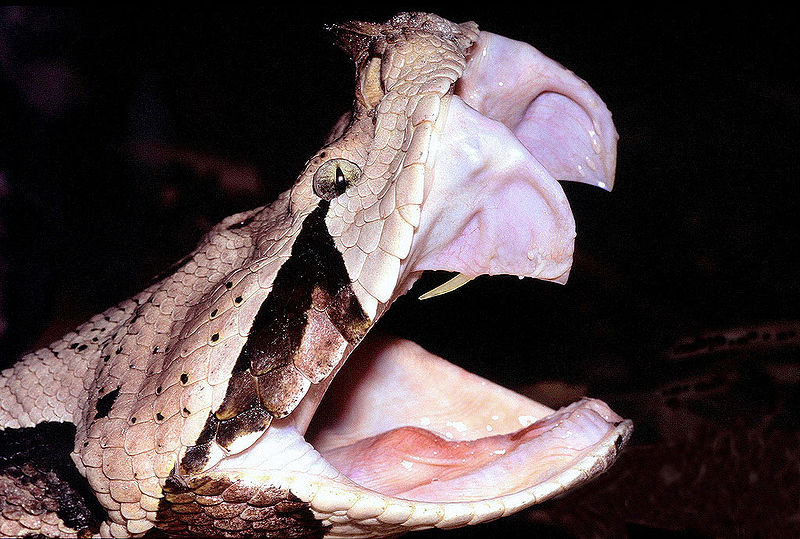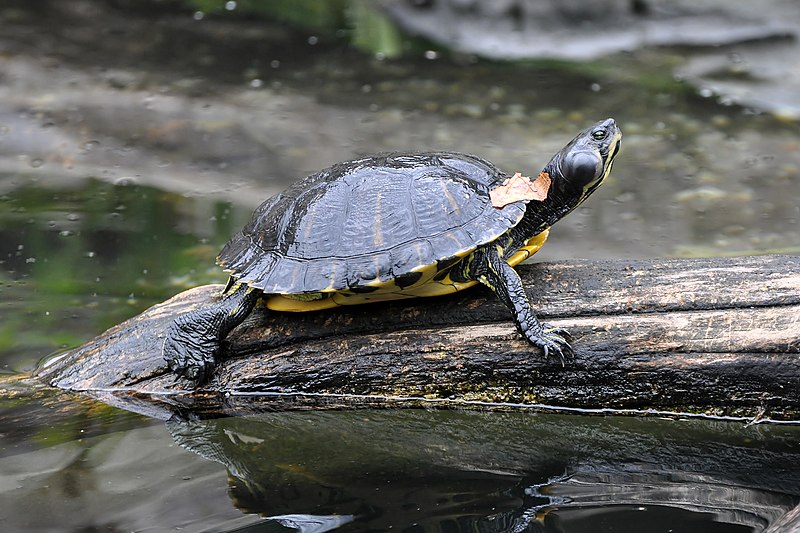A remote, mountainous forest in southwestern Tanzania is the only place where Matilda’s Horned Viper (Atheris matildae) resides. Described as a new species in the December, 2011 issue of Zootaxa, the boldly-colored, arboreal snake seems limited to 100 square miles of somewhat degraded habitat.
Natural History
Named for the daughter of one of the researchers who discovered it, Matilda’s Horned Viper is stoutly built, sports horn-like scales above the eyes and is highly-adapted to life above ground.
I’ve had the opportunity to work with several of its brightly colored relatives, but this did not prepare me for the new species’ amazing appearance; the effect of the black and yellow zigzag pattern is hard to describe (please see article below for additional photos). I’m not sure if these colors serve as a predator deterrent or as camouflage in sun-dappled forest clearings, but look forward to reading future reports on its natural history.
Bush Viper Diversity
The forests in which Matilda’s Horned Viper lives are separated from others by open grasslands, which effectively isolate the snake from related species. Genetic studies have revealed its closest relative to be the Usambura Bush Viper (Atheris ceratophora), from which it likely evolved some 2 million years ago.
An additional 16-17 Atheris species, commonly known as “Bush Vipers”, range throughout Sub-Saharan Africa (please see article below). With a single exception, they have prehensile tails and are highly-arboreal. Many are brilliantly-colored, and populations of a single species may vary greatly in appearance from others of their kind. Five species inhabit Tanzania, but their ranges do not overlap that of Matilda’s Horned Viper.
Endemics Galore
Tanzania is chock full of species found nowhere else on earth, known as endemics – 64 reptiles, 55 amphibians, 24 mammals, 108 freshwater fishes, 19 birds – and surveys are far from complete. Tarantula enthusiasts also know it as a country of unique, unstudied spiders. Please see the article below for a complete list of Tanzania’s endemic reptiles.
Conservation Strategies
Rare, beautiful snakes, even venomous ones, are worth a great deal of money. With this in mind, the exact location of the new species’ habitat is a closely-guarded secret, and a captive population has been established as a hedge against extinction.
In a surprising twist on traditional conservation techniques, researchers have announced that captive-born young, if produced, may be offered to collectors free-of-charge. It is hoped that this will deter the taking of wild individuals. Odd perhaps, but “desperate times require desperate measures” – after all, prohibitions on hunting rhinos and other valuable animals have proven largely ineffective in much of Africa.
CITES I and IUCN Critically Endangered designations have been proposed for Matilda’s Horned Viper as well.
Other New Vipers
 2011 was a banner year for viper researchers, with several new species being described. Please see the article below for more on Ruby-Eyed Vipers and other surprising finds.
2011 was a banner year for viper researchers, with several new species being described. Please see the article below for more on Ruby-Eyed Vipers and other surprising finds.
Further Reading
Abstract of article describing the new species
More photos of Matilda’s Horned Viper
Newly Discovered Yellow and Ruby-Eyed Vipers
Tanzania’s Endemic Reptiles
Bush Vipers: species and ranges
Atheris ceratophora image referenced from wikipedia and originally posted by Al Cortiz
Matilda’s Viper image referenced from wikipedia and originally posted by Christine Dell’Amore
Ngorongoro Crater image referenced from wikipedia and originally posted by William Warby
 As a career herpetologist, I’ve had several opportunities to study venomous snakes in the field, and have spoken with many people who live in areas where they are common. My experiences led me to believe that venomous snakebite is a far more serious problem than is typically reported. Recently, two important studies have established that at least 4.5 million people are bitten annually – 1.5 million in Sub-Saharan Africa alone. Yet snakebite was only recently included on the World Health Organization’s list of Neglected Tropical Conditions, and in many countries few victims receive appropriate treatment.
As a career herpetologist, I’ve had several opportunities to study venomous snakes in the field, and have spoken with many people who live in areas where they are common. My experiences led me to believe that venomous snakebite is a far more serious problem than is typically reported. Recently, two important studies have established that at least 4.5 million people are bitten annually – 1.5 million in Sub-Saharan Africa alone. Yet snakebite was only recently included on the World Health Organization’s list of Neglected Tropical Conditions, and in many countries few victims receive appropriate treatment. That Reptile Blog – Reptile, Amphibian and Exotic Pet Care and Information
That Reptile Blog – Reptile, Amphibian and Exotic Pet Care and Information




